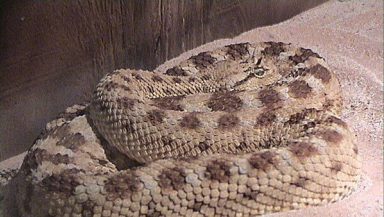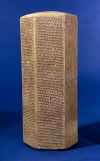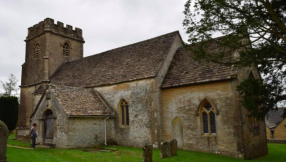
TE Lawrence – Lawrence of Arabia – was one of the great heroes of the First World War in the Middle East. He helped to raise the Arab tribes against the Ottoman Empire, lived among them and was involved in daring raids against forts and railways. During his exploits he travelled by camel and lived rough.
In one of his books about his experiences, Revolt in the Desert, he writes of travelling through a particular region. He says: "...the plague of snakes which had been with us since our first entry into Sirhan, today rose to a memorable height, and became a terror.. .this year the valley seemed creeping with horned vipers and puff-adders, cobras and black snakes. By night movement was dangerous: and at last we found it necessary to walk with sticks, beating the bushes while we stepped warily through on bare feet... they got so on our nerves that the boldest of us feared to touch the ground."
Terrifying stuff; and that was what the Israelites faced in the same area nearly 3,000 years before.
Numbers 21:1-9 tells of the people facing a plague of snakes after they complained against Moses because of the hardships of the journey. They even complained about the manna: "We detest this miserable food!"
When the snakes began to do their work, though, the Israelites turned their attention to them, instead. "Pray that the Lord will take the snakes away from us," they asked.
God's remedy was for Moses to put a bronze snake on a pole, so that anyone who was bitten "can look at it and live".
Nowadays anyone travelling in that region would take plentiful supplies of snakebite antidote with them. But this isn't medicine, it's miracle. So what is God saying through the story?
1. He doesn't stop us behaving stupidly, but he offers a way out.
We've all done things we regret. In the Israelites' case it was childish moaning about the hardships of their lives. For us, it might be anything from petulant behaviour to serious sin. But the lesson of the bronze serpent is that God is gracious and we can "look and live".
2. The snake was a transfigured representation of what caused the pain.
We don't get over hard times, whether we see them as the consequences of sin or just things that happen because life's like that, by ignoring them. Instead we have to confront them, acknowledge them and learn from them – and we find that God meets us with grace even in our darkest times.
3. People weren't healed by looking at the snake.
The snake was only the symbol of the power of God. In the 'Wisdom of Solomon', a book in the apocrypha, a Jewish commentator writes about this story and says: "If a person looked at that symbol, he was cured of the snakebite – not by what he saw, but by you, the saviour of all mankind... They were bitten so that they would remember your commands, but they were quickly rescued, in order to keep them from forgetting you completely and depriving themselves of your kindness. No medicine or ointment cured them. They were restored to health by your word, O Lord, the word which heals all humanity" (16:7, 11-12).
4. The snake prefigures the Lord Jesus Christ.
In John 3:14 Jesus says: "Just as Moses lifted up the snake in the wilderness, so the Son of Man must be lifted up, that everyone who believes may have eternal life in him." There's a similarity, but also a contrast: the Israelites were given life through looking at the snake, but when someone "looks" at Christ – and the implication is that the "look" is a plea for help and a trust in his grace – they're given eternal life. The contrast is the same as in John 4:14 when Jesus tells the woman at the well, "whoever drinks the water I give them will never thirst. Indeed, the water I give them will become in them a spring of water welling up to eternal life."
5. The snake became a snare.
The bronze snake was preserved by the Israelites as a treasured reminder of what they had experienced in their wanderings. But by around 700 years later it had become more than that. The people had given it a name, Nehushtan, and begun to worship it. King Hezekiah broke it in pieces when he destroyed the other idols that the people followed (2 Kings 18:4). The snake was a means of grace that became an object of worship. The people forgot the Creator in favour of the creature. God speaks to us today in different ways – great preachers, perhaps, or songs, or Christian conferences. We can give these things too much weight; they matter simply because they point us to him.
Follow Mark Woods on Twitter: @RevMarkWoods

















